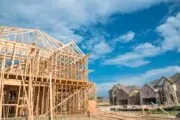
The number of young immigrants settling in Canada could impact the demand for housing, a trend that could also factor into Toronto’s new construction sector.
Canada’s immigration levels are at a high as a result of heightened targets by the federal government that were implemented to make up for shortfalls created by the COVID-19 pandemic. Last year, Canada welcomed 401,000 new immigrants — double the number of newcomers who arrived in 2020 — and is expected to hit immigration targets of 411,000 and 421,000 people in 2022 and 2023.
A CIBC report authored by deputy chief economist Benjamin Tal predicts that the rising proportion of new young adult immigrants may shorten the length of time between arriving in the country and purchasing a home.
On average, new immigrants tend to buy a property five or six years after their arrival. However, given that many young immigrants were already in Canada before the change in status, they might be in a position to purchase a home earlier, Tal’s report explained.
“We also suggest that housing demand is stronger than estimated by official figures due to the undercounting of household formation amongst new immigrants,” wrote Tal. “A pre-condition for any supply-led housing policy is a more accurate and realistic picture of actual demand.”
For newcomers looking to settle in Canada, Kevin Crigger, president of the Toronto Regional Real Estate Board (TRREB) predicted in a recent market update that condo demand will be “robust” in 2022 as increased immigration trickles into the Greater Toronto Area. Simon S. Mass, CEO of The Condo Store, also anticipates that a significant number of immigrants will settle in and around Toronto. This will have an impact on both home purchases and rentals in the region, he said.

“Toronto is on a path to truly becoming a much larger world-class city; this requires growth both in numbers, pricing and options,” said Mass. “Everything will be expanding, and for this to get to the point that Canada and Ontario want it to be, you need to have the population increasing consistently.”
With higher demand for housing comes the need to build and sell more of it. In terms of how Toronto’s new construction projects would respond to the rising population, Mass said that the market has already considered this with the offerings that are in place. Suburban areas around the City of Toronto will likely expand as the city grows. There may also be a small uptick in demand for larger units similar to the work from home movement, or in the luxury segment due to the change in philosophy about how people spend time at home, Mass explains.
However, Mass does not believe that increased levels of immigration in the coming years will have a drastic impact on what specific types and sizes of properties will be required to satisfy housing demand.
“There could be a slight change in what is built, but I think the approach and strategy by municipalities and builders that is occurring now will satisfy the needs for the foreseeable future,” he said. “Remember, developers are planning buildings now that will not see occupancy for five to 10 years, so these considerations have to be baked into the work being done today.”
In response to the future demand for housing, new construction investors are committed to their belief that supply shortages and strong Canadian immigration initiatives will “only get more aggressive for decades to come,” Mass explains. Given that Canada will not be able to solve its low housing stock quickly, the real estate market for investors is only going to become more lucrative as a result.
“Investors are overall working within their own parameters of buying properties in neighbourhoods that either neighbour where they live and work — basically where they are familiar with — or the exact polar opposite to this notion,” said Mass.

As recently reported by policy think tank Smart Prosperity Institute, population forecasts to gauge housing needs in the GTA and Hamilton have been inaccurate in the past, leading to a shortfall of 26,000 homes. If population forecasts from international migration are as off as they have been in the past, then the GTAH could require over 100,000 additional housing units over the next decade, the report stated. Mass hopes that more attention to Canada’s immigation program will stimulate changes to the development approval process, resulting in more housing supply.
“Hopefully the newsworthy-ness of Canadian immigration programs will help kickstart the necessary changes to the development processes that are needed in order to bring the required amount of housing, at all levels, to the GTA,” he said. “This macro impact, more than anything specific, will affect the market overall.”






